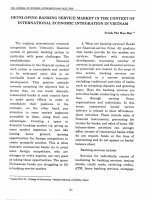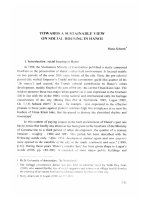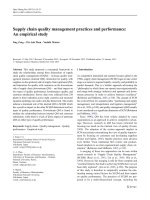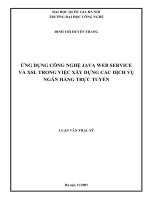DSpace at VNU: Towards scalable agent-based web service systems: Performance evaluation
Bạn đang xem bản rút gọn của tài liệu. Xem và tải ngay bản đầy đủ của tài liệu tại đây (1.46 MB, 4 trang )
Towards Scalable Agent-based Web Service Systems:
Performance Evaluation
∗
Quang-Dung Vu , Ba-Binh Pham, Dinh-Hieu Vo, Viet-Ha Nguyen
Department of Software Engineering
University of Engineering and Technology
Vietnam National University, Hanoi
144 Xuan Thuy Road, Cau Giay District, Hanoi, Vietnam
{dungvq, binhpb.mi10, hieuvd, hanv}@vnu.edu.vn
ABSTRACT
Web service technology is widely applied in building distributed information systems in order to provide flexibility
and extensibility. As in the traditional web services, when
the number of clients increases, the traffic problems of network may happen and the services may become overloaded.
Distributed mobile agent platforms in Web service have become more mature in recent years, and may help reducing
the load from Web servers as well as reduce the traffic for
overall network. We have proposed an agent-based framework for Web services that is scalable and reliable. The
framework uses mobile agents to solve the traffic problem
on traditional Web service systems. In this paper, we study
the performance of our proposed approach with the focus
on response time. We simulate our framework by mathematical models on a network simulator tool. The simulation
results showed that our proposed framework has ability to
improve performance in comparison with traditional Web
service systems.
based distributed applications on the Internet is described
in [7]. Another approach is using mobile agents as Internet
content transcoders is presented in [5].
In our approach with similar target, we have proposed
a framework for Web services based on mobile agents [6].
Using our framework may reduce load for Web servers as
well as overall network traffic. The key idea is to use mobile
agents to deliver services to client sides.
This paper presents a performance model and experiments
for proving the scalability of our proposed framework. Our
experiments are based on network simulators and only focus
on response time. The remainder of the paper is organized
as follows. In Section 2, we review our proposed framework.
Section 3 presents our performance mathematical model for
mobile agent-based Web services systems. An experimental
case of system performance based on network simulator together with results and discussion are presented in Section 4.
And the last section - Section 5 are the conclusions and our
future work.
Keywords
2.
web services, mobile agents, performance, response time
In this section, we give an overview of our proposed framework for reducing load and increasing performance for Web
service systems. A mobile agent is a software component
that has the ability to move from one host to another while
preserving its state. It has been utilized for adaptation to
various environments, typically mobile computing environments [3, 8].
In our framework [6], there are three main layers: web
servers, proxy servers, and clients. Each group of clients in
the same network area is coupled with a proxy server. These
clients and the proxy servers can be very far away from the
web servers. Both web servers and proxy servers have mobile
agent platform installed. When clients in a group (i.e. use
the same proxy server) make the same requests, the proxy
server determines whether to forward the request directly
to the web servers or to request the web servers to send a
mobile agent to carry out service at the proxy server. With
this mechanism, the response times of services are decreased
because clients only need to connect to proxy servers instead
of connecting to web servers. It also will prevent the problems of bottle-neck and overload at the server sides. The
overview of framework can be seen in Figure 1.
The core of the framework is i) a service is composed by a
number of agents, and ii) the use of the mobility of agents to
carry the reallocated service to the proxy server and to execute it there. Among to proposed framework, a proxy could
1.
INTRODUCTION
In recent years, Web service technology is considered as
an effective means for building distributed information systems. Based on a set of standards (XML, SOAP, WSDL,
etc.), Web service technology provides systems with flexibility and extensibility. However, to exploit the benefits of
this technology, many issues must be solved including the
performance of services. With the aim of increasing performance of systems based on Web services, several researches
have been carried out. The idea of using distributed servers
with replicated resources is proposed in [2, 4, 1]. An infrastructure for the design and the development of mobile agent
∗Corresponding author
Permission to make digital or hard copies of all or part of this work for
personal or classroom use is granted without fee provided that copies are
not made or distributed for profit or commercial advantage and that copies
bear this notice and the full citation on the first page. To copy otherwise, or
republish, to post on servers or to redistribute to lists, requires prior specific
permission and/or a fee.
iiWAS2011, 5-7 December, 2011, Ho Chi Minh City, Vietnam.
Copyright 2011 ACM 978-1-4503-0784-0/11/12...$10.00.
481
BACKGROUND
Figure 2: Response time model.
Figure 1: Overview of our proposed framework.
to get agent from server is ts . Also, a time of completed
the first request is treq0 , and a time of competed the first
response is tresp0 from a client to proxy and server. We have
a following conditions:
investigate itself in possibility of containing agent, and provide the mechanism to communicate with other agents. It
can improve a performance and reliability of systems. The
problem remains that, there is not enough experiments in
proving the realizing of proposed framework. And to achieve
scalability as shown in proposed approach, we need to prove
the performance of our proposed framework.
3.
tag ≥ t1 + t0
tag ≥ t2 + t0
Thus, we have
t1
t2
PERFORMANCE EVALUATION MODEL
where x0 , y0 are the time related with a received data unit,
and dependent to server’s speed, memory and transmission
systems.
We will have a formula of overall agent transaction from
server to client as follows
In this section, we propose a model for evaluating a performance of scalable mobile agent based web service systems.
The mathematical model is based on software architecture
of network systems using mobile agents. It models the transferred agents among request and response time. The model
will realize a performance of systems by finding the response
time value on each transaction agent.
3.1
treq0 .rreq + x0
(tresp0 − ts ).rresp + tresp0 + y0
tag = t1 (ε + 1) + t2 (ε + 1) + t0
with ε ∈ [0, 1] is a value of delayed network on request processing. The response time is shown in Figure 3, in which,
the response time is a monotonic function. In comparison
with traditional web service systems, the response time of
mobile agent systems will always be smaller.
Response time model
Firstly, we describe our model of response time in mobile
agent based web service systems, where mobile agent platform is installed in proxy server and web server sides. The
overall system is shown in Figure 2. We calculate the response time in this system when proxy carries agent. The
performance is critical and should be affected by reducing
the load of requests from clients and reducing the response
time to get result from client side.
In order to measure the overall performance of our proposed
systems, we adopt some definitions of request and response
to the client side. These definitions will effect the response
time of web service systems. We define the mathematical
model as below.
Suppose that the number of requests and the number of
responses are defined as rreq and rresp , respectively. We
define tag as response time of agent based web services, t1 , t2
are request and response time of agent, and allocated time
3.2
Scalable model
With increasing the number of requests, i.e increasing
number of clients, the systems need to be designed as scalable proxy servers. We propose a scalable model that will
control distributed agents and responses on the success transferred. The process is shown in the Figure 4. In that figure,
each proxy server has a connection to one client as a local
network, which can be quickly response to requests of client.
A connection between proxy servers and web servers is the
Internet. Thus, the total response time of systems includes
all the response time of each agent in the network.
We define set of relation values in order to verify a existing proxy server which carries agent and return to client’s
requests.
482
sponse time can be formulated as following:
Tresp =
(treq + tresp ) + tagj + ∇τ
where
∇τ =
wc .scost + wt .stime + wa .savail
0
with agent
no agent
with wc , wt , wa are the priority values of request which turn
of cost, time and available of services. And scost is cost
of service, stime is response time and savail is available of
service.
Through scalable systems, our proposed platform depends
on the available carried agent in proxy, and it could connect
or reallocate to web server in order to get response agent to
the requested client.
Figure 3: Mathematical graph of response time.
4.
Figure 4: Scalable model.
Def 1. Response value d ∈ [0,1], that is defined as follows:
d=
1
0
proxy server carries agent
proxy server locates to web server for agent
Def 2. Response function sij could be formulated as follows:
sij =
i
0
response from proxy server carried agent
response from web server located agent
Def 3. Response condition uij will be as sum of response
function and its priority of request.
uij =
wj .sij
j
where wj ∈ [0, 1] is priority of request j. In scalable system,
one request will be processed at one time, thus priority value
is happened to define it. When w = 1 means that the request
of one client is processed, otherwise if w = 0 - system is
looking for priority value on overall network.
Total time is shown as:
T =
EXPERIMENT
Our experiment bases on network simulator tool with the
focus on simulation of web service systems using mobile
agents. In the tests, we establish two levels of load management. The first one is simulated as a local network including
clients and proxy servers. The second one is simulated as the
Internet with one web server. We assigned for first level a
DNS address, and each client is given an IP address of proxy
server based on locally. The second level of load balancing is
via proxy server which dynamically distributes transactions
among a group of proxy servers. In local network, each client
can connect to a proxy server. It gives faster response time
and reduces unnecessary traffic in the networks. The test
system examines all agents that are moved between the web
server and proxy servers. Specific functions of proxy servers
are to: (a) inspect all agents in both directions between web
server and proxy servers; (b) look for needed agents existing
inside proxy server; (c) if no agents found in proxy server,
locate them to web server; (d) receive agent from web server;
(e) response to clients; and (f) watch for next request and
agents.
We performed 5 clients sending approximately 3000 requests to proxy servers within 100 ms based on 10Mbps
speed of local network. We made a random of thousand
times of sending a set of requests to a server with by 10 ms
for each. The requests were sent continuously with number
of requests increasingly. The Internet connection in use had
speed of 128Kbps. An experimental example is shown in
Table 1 with some testing values. In the table, the first column is the number of sending requests, the second column is
the interval of sending request, and the next 2 columns are
the response time of our proposed framework and traditional
web services. In the table, when the number of requests is
increased to a sufficient value, the response time is always
smaller in comparison with traditional web service systems.
In experiment, we compare our systems with traditional
web service systems. The comparison is shown in Figure 5.
In that figure, the vertical axis is the response time values
that measures in ms. The horizontal axis is the number of
requests. The dot line is the response time of mobile agent
based web services, and the other line is response time of
traditional web services. The first request is sent to web
server to allocate agent, and on the next time if the agent
is in proxy, then proxy server will send response back to
requested client without allocating to web server and so on.
Thus it reduces the time of receiving response to client side.
tagj .uij
j
In combination of two subsections 3.1 and 3.2, the total re-
483
Table 1: Experimental result
Number of Request Resp. time Resp. time
request
interval web service agent based
(ms)
(ms)
(ms)
1
0
0.000
0.012
2
0
0.312
0.012
21
10
0.208
0.018
25
10
0.204
0.024
93
20
0.505
0.028
97
20
0.505
0.028
252
30
0.514
0.030
257
30
0.505
0.034
373
40
0.609
0.032
378
40
0.705
0.042
647
50
0.809
0.052
648
50
0.909
0.054
961
60
0.909
0.062
964
60
1.013
0.063
1455
70
1.129
0.071
1461
70
1.304
0.081
1480
80
1.309
0.087
1483
80
1.409
0.096
1845
90
1.613
0.112
1846
90
1.845
0.224
2727
100
2.606
0.291
2750
100
2.132
0.403
Figure 5: Response time comparison graphs.
7.
As seen in the graph, the response time for next request
is lower than a previous request, and that process improves
the performance of systems and avoids the traffic in network
transaction. In the comparison graph, the response time of
our model is smaller than in the traditional system.
In experiments, we have shown that our proposed system
has high performance in comparison with traditional web
services with more effective, high scalability, availability, and
reliability.
5.
CONCLUSION
In this paper, we have shown mathematical models which
evaluate the performance of our proposed systems. We have
simulated our models by using network simulator tool with
the focus on response time. The results have shown that
our system is scalable and reliable. The proposed system
can solve the bottle-neck and overload problems which usually happened in traditional web service systems. Our system has higher performance in comparison with traditional
web service systems. In the future, we will develop more
complex web service systems with using mobile agent with
regard to composite web services. Also, we are continuing to
implement an application based on our proposed framework
which will realize a transaction of mobile agents for overall
network.
6.
REFERENCES
[1] G. Cabri, L. Leonardi, and F. Zambonelli. A
proxy-based framework to support synchronous
cooperation on the web. Softw. Pract. Exper.,
˝
29(14):1241U–1263,
1999.
[2] J. Cao, Y. Sun, X. Wang, and S. K. Das. Scalable load
balancing on distributed web servers using mobile
agents. Journal of Parallel and Distributed Computing,
63(10):996–1005, 2003.
[3] G. Chen, J. Lu, J. Huang, and Z. Wu. Saaas - the
mobile agent based service for cloud computing in
internet environment. In Proc. Sixth Int Natural
Computation (ICNC) Conf, volume 6, pages 2935–2939,
2010.
[4] L. Cherkasova. Flex: load balancing and management
strategy for scalable web hosting service. In In
Proceedings of the Fifth International Symposium on
Computers and Communications, 2000.
[5] J. L. Hsiao, H. P. Hung, and M. S. Chen. Versatile
transcoding proxy for internet content adaptation.
IEEE Transaction on Multimedia, 10(4):646–658, 2008.
[6] V.-H. Nguyen, T. D. Bui, Q.-D. Vu, and N. T. T. Hien.
Towards scalable agent based web service systems. In
Proc. 4th Int New Trends in Information Science and
Service Science (NISS) Conf, pages 210–213, 2010.
[7] A. Omicini and F. Zambonelli. Coordination for
internet application development. Journal of
Autonomous Agents and Multi-Agent Systems,
˝
2(3):251U–269,
1999.
[8] Z. Zhu, J.-Y. Wang, Z. Yang, and F. Lei. Internet
information retrieval system based on mobile agent. In
Proc. Int Machine Learning and Cybernetics Conf,
volume 1, pages 62–66, 2005.
ACKNOWLEDGEMENTS
This work is partly supported by the research project No.
102.02-2010.06 granted by NAFOSTED Vietnam. The authors also thank TRIG project at VNU for providing the
research environment.
484









